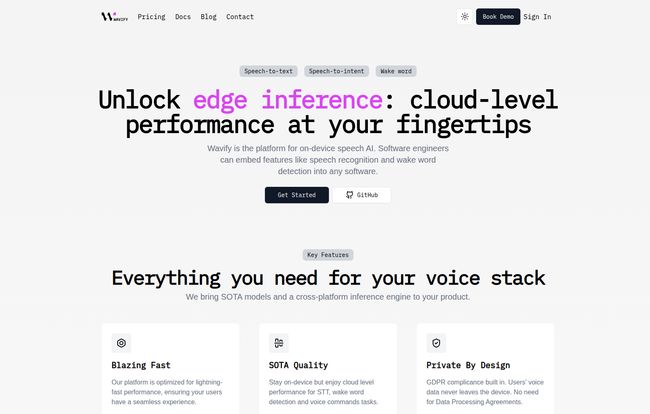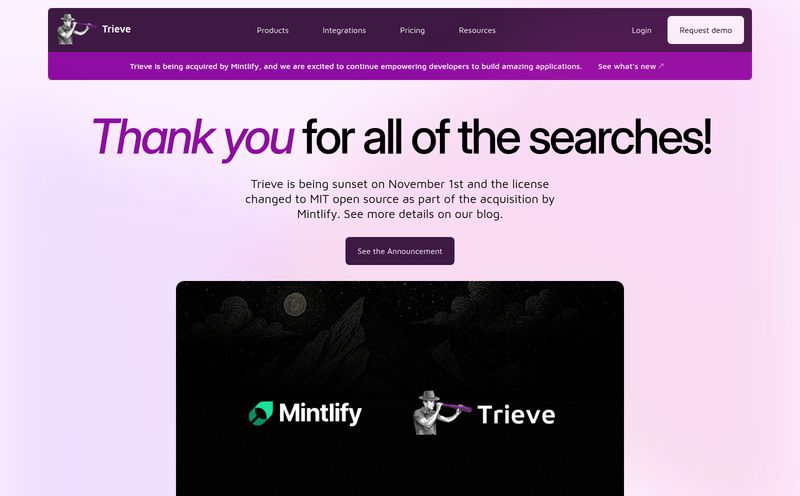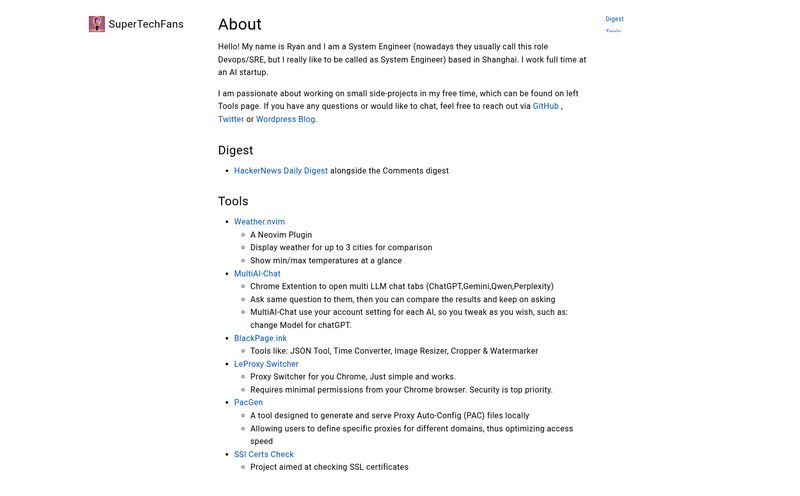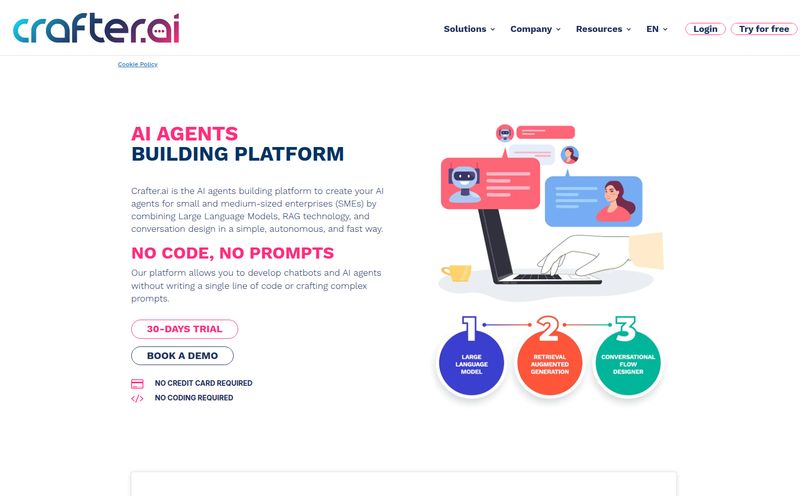As developers, we’ve all been there. You get a brilliant idea for an app that uses voice commands. Something slick, responsive, and futuristic. You start looking at the big-name cloud APIs for speech-to-text, and a familiar sense of dread creeps in. You're thinking about latency, right? That awkward pause after a user speaks, waiting for the audio to make a round trip to a server farm halfway across the world and back. Ugh.
And that’s before you even get to the privacy talks with your boss or clients. "So, where does the user's voice data go?" they ask. You mumble something about secure servers and encryption, but we all know the truth: you're shipping private conversations off to a third-party. It feels… kinda gross. Especially in this GDPR-era we live in.
For years, this was the tradeoff. You want powerful speech recognition? You have to pay the cloud toll in both latency and privacy. But what if you didn't have to? I recently stumbled upon a platform that’s making a pretty bold claim: cloud-level performance, right on the device. It's called Wavify, and honestly, I'm a little bit excited.
So What Exactly is Wavify?
In a nutshell, Wavify is a toolkit for software engineers to build voice features like speech recognition, speech-to-intent, and wake word detection directly into their applications. The magic words here are
on-device.
This means all the heavy lifting, the actual AI inference, happens locally on the user's phone, laptop, or even a tiny Raspberry Pi. No data is sent to the cloud. None. It never leaves the device. This isn't just a feature; it's a fundamental shift in how we can build voice-enabled products.

Visit Wavify
Think of it like having a miniature, highly-optimized voice processing expert living inside your app, instead of having to call one on the phone every time you need something transcribed. This approach has some massive benefits that are worth talking about.
What Makes Wavify Catch My Eye?
I’ve seen a lot of tools come and go. Most are just slight variations on the same old theme. Wavify feels different. It’s tackling the core problems that have bugged me about voice AI for years.
It's Fast. Stupid Fast.
Okay, “blazing fast” is a marketing term that gets thrown around a lot. I’m usually skeptical. But Wavify puts their money where their mouth is with actual numbers. They published a runtime performance comparison on a Raspberry Pi 5, of all things. You know, the little hobbyist computer.
Against popular open-source models like `whisper.cpp` and `whisper.tiny`, Wavify wasn’t just a little faster; it blew them out of the water. For a 4.91s audio file, Wavify processed it in just 2.31s. That’s a real-time factor of 0.45. For comparison, `whisper.cpp` took over 20 seconds. That's the difference between a seamless user experience and a frustratingly laggy one. Speed like this on local hardware is, frankly, impressive.
Privacy Isn't an Afterthought; It's the Default
This is the big one for me. By processing everything on-device, Wavify makes your application private by design. You’re not just promising users you’ll be good with their data; you’re building a system where you physically can't be bad with it. It never touches your servers. It never leaves their phone or computer.
This is a game-changer. You can build a voice-activated journaling app, a medical transcription tool for doctors, or a kids' game without the ethical and legal nightmare of handling sensitive voice data. You can confidently say you are GDPR compliant because you aren't processing personal data off-device. It’s like building a digital fortress for user conversations, and you get it for free just by using the platform.
It Plays Nice with (Probably) Everything You Use
There's nothing worse than finding a cool new tool that requires you to completely re-architect your entire project. Wavify seems to get this. It’s built to be cross-platform, running on:
- Linux, macOS, and Windows
- iOS and Android
- Web (this is huge!)
- Raspberry Pi and other embedded systems
Their SDK integration looks ridiculously simple, at least from the Python example on their homepage. It's basically three lines of code to get a transcription from an audio file. This low barrier to entry is huge for developers who just want to experiment and see if it fits their needs without committing to weeks of integration work.
Who Should Be Looking at This?
While the obvious answer is "any developer using voice," I think it's particularly compelling for a few specific areas.
The site calls out Healthcare, and that’s a perfect example. Imagine doctors being able to dictate notes directly into a patient's file on a tablet, with the confidence that no sensitive PHI (Protected Health Information) is being beamed to a random server. It could streamline documentation and reduce administrative overhead, all while maintaining strict patient confidentiality.
But I also see huge potential in other fields. Think about in-car systems where internet connectivity can be spotty. Or accessibility tools that need to be hyper-responsive to help users navigate their device. Or even smart home gadgets where users are (rightfully) getting more and more paranoid about what their devices are listening to. The multilingual support just widens that net even further.
Let's Talk Money: The Wavify Pricing Breakdown
Alright, this is often the make-or-break moment. When I first heard about Wavify, I couldn't find a pricing page, which is always a red flag for me. But they’ve since put one up, and it’s refreshingly straightforward.
| Plan | Price | Key Feature |
|---|---|---|
| Free | €0 | Use on up to 5 devices, no credit card needed. |
| Starter | €150 / month | Use on up to 100 devices. |
| Enterprise | Contact Sales | Limitless processing, custom features, and support. |
The Free tier is genuinely useful. Five devices is more than enough to build out a proof-of-concept, test the performance on all your target platforms, and really kick the tires before you commit a single euro. The Starter plan at €150/month for 100 devices seems very reasonable for small to medium-sized applications. And the Enterprise tier is there for the big players. This pricing structure feels fair and designed to grow with a project.
Any Downsides? A Moment of Honesty
No tool is perfect. One potential hurdle is that, yes, you do need to have some technical chops to integrate an SDK. This isn’t a no-code drag-and-drop solution. You’ll need to be comfortable working with code. That said, based on their documentation and Python example, it doesn't look like you need to be a machine learning PhD to get it running. If you've ever integrated any third-party library, you'll likely be fine.
My Final Take on Wavify
I'm genuinely optimistic about what Wavify is doing. They aren't just building another speech-to-text API. They are addressing the fundamental flaws of the old cloud-centric model. The combination of blistering on-device speed, a privacy-first architecture, and broad platform support is a potent mix.
It feels like a tool built by engineers, for engineers, who were fed up with the status quo. If you're building anything with a voice component, you owe it to yourself and your users to at least sign up for the free tier and give it a spin. This might just be the solution you’ve been waiting for.
Frequently Asked Questions
What is Wavify?
Wavify is a software platform that allows developers to add on-device speech AI features, like speech-to-text and wake word detection, into their applications. Because it runs on-device, it's very fast and completely private.
Is Wavify free to use?
Yes, Wavify has a generous free plan that lets you use the service on up to 5 devices without needing a credit card. They also offer paid plans for projects that need to support more devices.
Does Wavify process my voice data in the cloud?
No, and this is its main advantage. All voice processing happens directly on the user's device (e.g., their phone, computer, or embedded system). No audio data is ever sent to Wavify's servers or any other cloud service.
What platforms does Wavify support?
Wavify is cross-platform and supports a wide range of operating systems, including Linux, macOS, Windows, iOS, Android, Web browsers, and embedded systems like the Raspberry Pi.
How does Wavify's performance compare to other models?
Based on their own benchmarks, Wavify is significantly faster than other popular on-device models like Whisper. It's designed for near-instantaneous response times, making for a much smoother user experience.
What about different languages?
Wavify is designed to be multilingual, supporting a diverse range of languages to enable developers to build applications for a global audience. You would check their documentation for a current list of supported languages.



